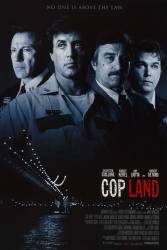Corrected entry: When Sylvester Stallone is asked why he couldn't join the NYPD, he points at his left ear and says it was because of deafness...but his deaf ear was the right.
Corrected entry: In a scene between Liotta and Stallone on the front porch, Liotta deliberately lays his beer can on its side on the porch railing. In the next scene it is standing upright.
Correction: The can is upright because Liotta puts it upright himself on camera.
Corrected entry: Midway through the film a character speaks to Stallone from the back of his squad car and then gets up and leaves. I thought you couldn't open the back door of a police car from the inside.
Correction: The guy in the back is also a cop and would know that so just didn't close the door when he got in.
Corrected entry: In the flashback scene where the young Freddy is in the submerged car, he uses the side of his head to smash the window from inside, but the glass breaks just before he hits it for the last time.
Correction: In the DVD version we don't see the glass break and I see nothing else unusual about this scene.






Correction: He used his left hand to point to his head generally to indicate deafness, not specifically to his left ear.
Watchful